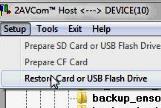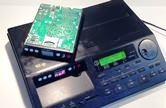Tools

The following auxiliary operations are available in the Tools menu.
“Set Protect All Banks” – enabling global write protection for all databanks.
“Clear Protect All Banks” – removing global write protection from all databanks.
“Format Banks” – formatting the databanks. After selection of this function the format window comes up. “From” represents the starting databank and “to” the ending databank. The Max button sets the maximum possible number of the ending bank. The following commands are available: “Run” and “Stop” the operation, and “Close” the window.
“Backup Banks” – creating an image of databanks in the PC selected directory. Selection of this function calls up the image creation window. “From” represents the starting databank and “to” the ending databank. The Max button sets the maximum possible number of the ending bank. The following commands are available: “Run” and “Stop” the operation, and “Close” the window.
“Restore Selected Banks” – retrieving the databanks from the bank images. Prior to this operation, pre-select the databanks in the central window. The number in the bank name indicates the bank to be restored.
“Update Firmware” - updating the controller software. Having selected this function, first, choose the update file to be downloaded from site.
Then quit the program, switch off the synthesizer and disconnect the cable. Upon switching the synthesizer on again, the UniFlash controller saves the updated software to its memory within a few seconds and resumes its normal operation. During the updating process, the display screen is blank and lit green.
“Prepare SD Card” – preparing a new Secure Digital (SD) card. The SD card should be in a card reader connected to a PC. After selecting this function, the SD card preparation window comes up. Here, you can select the type of the synthesizer for which this card is to be used and the number of databanks (1…999). This portion of the card space will be hidden from Windows and is accessible only via this software, so the amount of the card space available for Windows decreases accordingly. The portion of the space available is used to store audio files. Having set the required parameters, press “Run”. After that, disconnect the card reader from the PC and reconnect it in 10 seconds. Windows will detect the changes which have happened to the disk and may suggest formatting the new disk. Agree and select FAT 32 file system. Start formatting and when it is over, close the format window. Press “Run” in the SD preparation window again. After this, the window will close. Press “Connect” to proceed with the databank operations. Now, you have to format all banks and then you can use them to copy your files.
“Prepare CF Card” – preparing a new Compact Flash (CF) card. The CF card should be in a card-reader connected to a PC. After selecting this function, the CF card preparation window appears. Here, you can select the type of the synthesizer for which this card is to be used. The maximum number of databanks is 199. The remaining space is out of use. The card will not be accessible for Windows; it will be accessible only via this software. Upon connecting this card, Windows will suggest its formatting. Please, do not agree, otherwise you can lose your information. Having set the required type of the synthesizer, press “Run”. The window will close thereafter. Then disconnect the card reader from the PC and reconnect it in 10 seconds. Windows will detect the changes which have happened to the disk and may suggest formatting the new disk. Do not agree. Press “Connect” to proceed with the databank operations. Now, you have to format all banks and then you can use them to copy your files.
** If you format the card, it will turn into an ordinary CF card. Should it happen by chance, you can restart preparing a new CF card at once. In this case, some of the starting banks may be lost but you can retrieve the remainder.
← Back to Section


